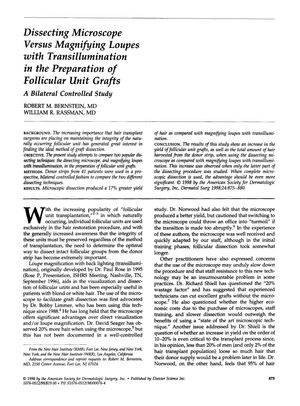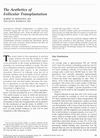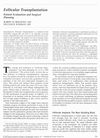Dissecting Microscope Versus Magnifying Loupes with Transilluntination in the Preparation of Follicular Unit Grafts
August 1998
in “Dermatologic Surgery”

TLDR Dissecting microscopes give more and better quality hair grafts than magnifying loupes.
In a study from 1998 involving 41 patients, the use of dissecting microscopes for preparing follicular unit grafts was compared to magnifying loupes with transillumination. The results indicated that the dissecting microscope technique yielded 10% more follicular units and 17% more total hairs than the magnifying loupes. Additionally, the average number of hairs per implant was higher with the microscope (2.28) compared to the loupes (2.14), and there were fewer hair fragments in discarded tissue. Although initially the microscopic dissection took longer, the time required decreased with experience to only 25% longer than the loupes. The study concluded that dissecting microscopes significantly increase the yield and quality of grafts, which is crucial due to the limited availability of donor hair in restoration procedures.
View this study on journals.lww.com →
Cited in this study

research The Aesthetics of Follicular Transplantation
The document concludes that good cosmetic outcomes in hair transplantation depend on the surgeon's artistic skill and careful planning.

research Follicular Transplantation
Careful planning and patient counseling can lead to excellent hair transplant results, often in one or two sessions.
Related

research Dissecting Microscope Versus Magnifying Loupes with Transilluntination in the Preparation of Follicular Unit Grafts
Dissecting microscopes give more and better quality hair grafts than magnifying loupes.